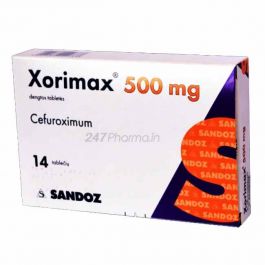Contents
Xorimax is a systemic antibacterial agent. Beta-lactam antibiotic used to treat bacterial infections. Useful in the treatment of light and moderate infections (pharyngitis, tonsillitis, infections of the lower and upper respiratory tract). The drug is available by prescription in the form of tablets.
Xorimax, Producer: Sandoz / Lek Polska
| form, dose, packaging | availability category | the active substance |
| sugar-coated tablets; 125 mg, 250 mg, 500 mg; 10 pieces | prescription drug | cefuroksym |
Indications of Xorimax
Treatment of the following mild to moderate infections caused by bacteria susceptible to cefuroxime:
- upper and lower respiratory tract infections – acute otitis media,
- pharyngitis,
- inflammation of tonsils,
- sinusitis,
- acute bronchitis,
- exacerbation of chronic bronchitis,
- uncomplicated lower urinary tract infections – cystitis, uncomplicated gonorrhea – urethritis and cervicitis,
- skin and soft tissue infections – e.g. furunculosis, pyoderma, impetigo, early stage of Lyme disease and prevention of its late complications in adults and children over 12 years of age.
Xorimax and contraindications
Contraindications:
- hypersensitivity to any of the ingredients of the preparation or to other beta-lactam antibiotics, e.g. from the group of cephalosporins.
- Do not use the preparation in patients with penicillin hypersensitivity, because they may also be hypersensitive to cephalosporins (including cefuroxime).
Dosage
Adults and children over 12 years of age:
- Infections of the upper respiratory tract: 250-500 mg twice daily.
- Infections of the lower respiratory tract: 500 mg twice daily.
- Infections of the skin and soft tissues: 250-500 mg twice a day.
- Uncomplicated lower urinary tract infections: 125-250 mg twice daily.
- Early stage Lyme disease: 500 mg twice daily for 2 days.
- Uncomplicated gonorrhea: single dose of 1 g.
Children 5-12 years old:
- Indications as for adults, if they occur in children in this age group: 125-250 mg twice a day.
- Acute otitis media: 250 mg twice daily.
Xorimax tablets are not intended for use in children under 5 years of age. In this age group, the doctor may recommend using the preparation in a different form. There is no clinical experience with the use of cefuroxime axetil in infants less than 3 months of age.
In the elderly or with impaired renal function, no special precautions are necessary, as long as the daily dose does not exceed 1 g. Caution should be exercised when the creatinine clearance is less than 20 ml / min. Patients undergoing hemodialysis require a special dosing schedule.
Use orally. Xorimax should be taken soon after a meal. The tablets should be swallowed whole and not chewed, broken or crushed.
Xorimax – drug warnings
- Parallel use of antacids with Xorimax is not recommended.
- Xorimax may interfere with some methods of measuring blood glucose.
- If diarrhea occurs during or after use, do not treat it yourself, but consult your doctor. There is a risk of pseudomembranous enteritis, sometimes severe.
- Be sure to consult your doctor before using the preparation and inform him if you have ever experienced hypersensitivity reactions to cephalosporins, penicillins or other drugs or allergens.
- Do not use during pregnancy (unless considered necessary by your doctor).
- Do not use in breastfeeding women as cefuroxime passes into breast milk.
Xorimax and interactions
Inform your doctor if you are taking:
- aminoglycoside antibiotics,
- amphotericin,
- diuretics (e.g. furosemide)
- antacids,
- drugs with bacteriostatic action (e.g. chloramphenicol, macrolide antibiotics, erythromycin, tetracyclines, sulfonamides),
- samplesecyd.
Xorimax – side effects
Xorimax is a preparation the use of which may cause: dizziness, diarrhea, nausea and abdominal pain, transient increases in liver enzymes, headache, positive Coombs test, thrombocytopenia, leukopenia, vomiting, skin rashes, anaphylaxis, Jarish-Herxheimer reaction, pseudomembranous colitis, jaundice (mostly congestive) ), hepatitis.










